
As folks were preparing to cut the cake in honor of the Complete Streets Day motion put forth by Councilmember Jose Huizar at City Hall last week, I was getting geared up to volunteer at a high school located in his district, around which many of the streets are decidedly incomplete.
I had run into Roosevelt High School teacher extraordinaire Jorge Lopez a couple of weeks prior; students from his food justice class were helping give a tour of two corner markets that had received healthy makeovers courtesy of Public Matters. When he heard I was interested in interviewing the students involved in the project, he suggested I stop in his classroom instead and assist the students in reworking their own interviews with food activists and workers in the area into articles.
Hell, yes! I thought.
Teens -- besides being inspiring to work with -- are often incredible, unfiltered informants about the unique dynamics of their communities and how those dynamics impact mobility, health, and access to opportunity.
When I first worked with his English class two years ago, students were writing speeches about things they would like to see improved in their neighborhood. Given the myriad challenging circumstances that the youth came from, immigrant rights, living wages, affordable housing, protection from gang activity, and access to healthy food and other health resources unsurprisingly figured prominently into their discussions.
But, I was also struck that one of the recurring themes was an inferiority complex many expressed with regard to East L.A.
It was so much cleaner, they complained.

When we think of "Complete Streets," we tend to focus on ways to facilitate mobility by "design[ing] and operat[ing streets] to enable safe access for all users, including pedestrians, bicyclists, motorists and transit riders of all ages and abilities."
But, for these students, it was clear that having streets that looked clean, inviting, and safe was important for mobility and access, too.
In comparing their neighborhoods to East L.A., many voiced a belief that people in East L.A. took more pride in their community because the sidewalks and streets there were well taken care of. Boyle Heights streets', they said, felt run down and forgotten.
It was something that bothered them a lot.
They were writing the speeches just as their school was getting ready for the East L.A. Classic, the homecoming football game between their school and Garfield (in East L.A.). And, they were tired, they said, of feeling like people from East L.A. were looking down on them because their streets were so dirty.
Many of the problems they named then continue to plague the area today.
Like dumping, for instance.
Dumping on corners.
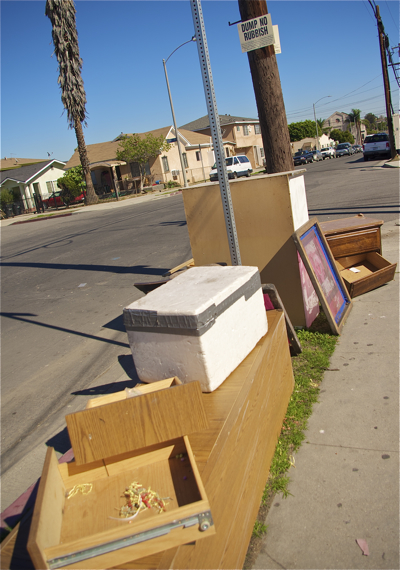
Dumping in front of homes.
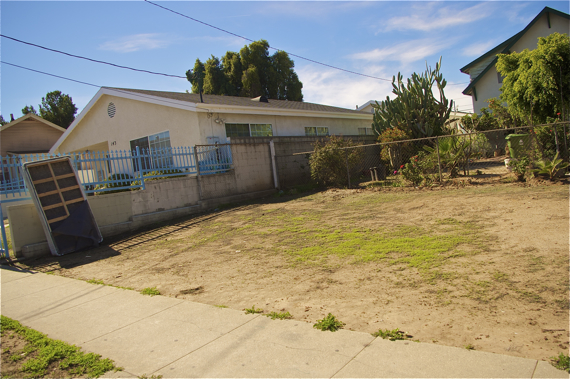
And, dumping in combination with scraggly-looking parkway grass and curb areas that make it look like the street is in a perpetual state of disrepair.
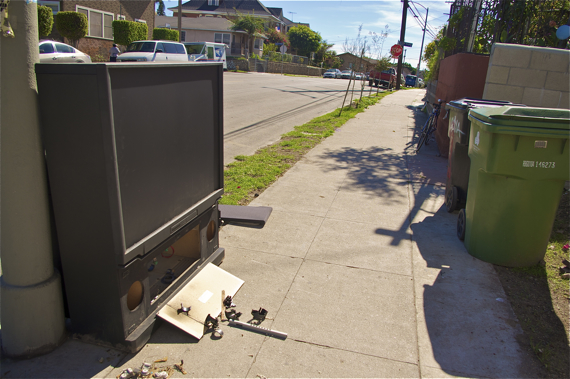
Trash accumulating along vacant spaces, along sidewalks and curbs, or along underpasses is also a problem.
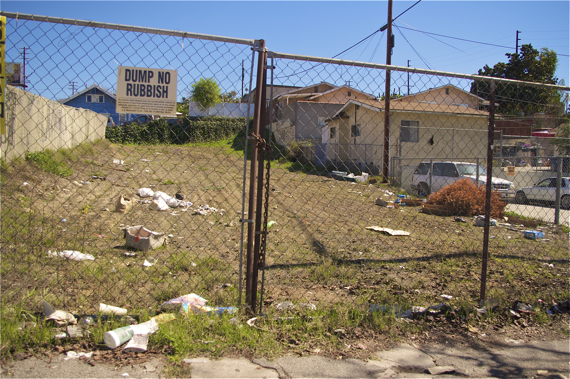

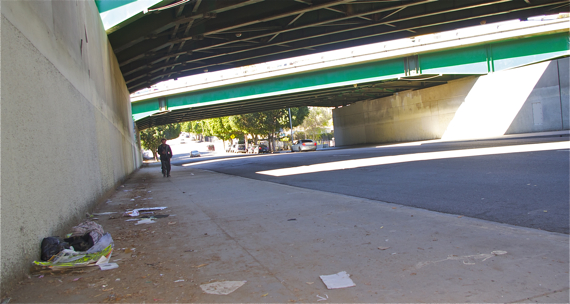
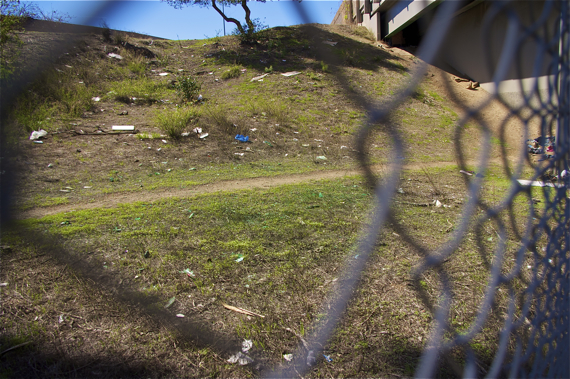
The problem has gnawed at the community so long, in fact, that community activist and graduate student (in social work) Amanda Mejia finally got fed up and organized her own grassroots clean-up.
Dubbing her initiative "Boyle Heights Rising," she managed to get friends, youth groups, church groups, independent do-gooder groups, and firemen (along with a yummy donation from Zamora Bros. Cantina) to come out in droves and spend their Saturday morning sweeping the sidewalks and picking up trash in the neighborhood of the Evergreen Cemetery.
She was heartened to see that there was less trash around the cemetery jogging path than there had been when they did their first clean-up a few months ago, she said, but there was still much left to be done.
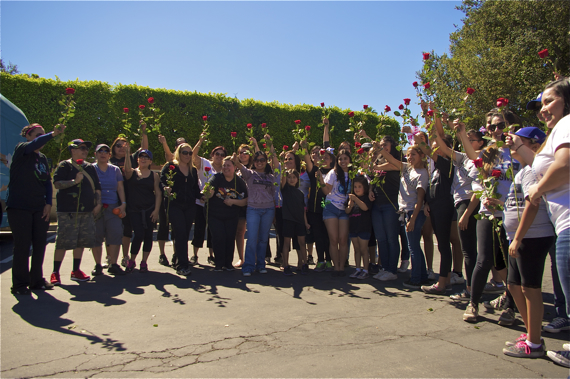
Of course, that doesn't mean that more traditional Complete Streets concerns are not also an issue here.
After leaving the clean-up, I rode up and down Lorena, a main street that cuts north-south across Boyle Heights.
Just a handful of blocks from Roosevelt High School, it is one that I have seen many students cross or walk along on their way to and from school. And, it is truly a wonder that they haven't been killed in the process.
While there is some bike infrastructure north of 3rd, when Lorena approaches the underpass at 4th St., everything changes for the worse. Lorena narrows, the bike lane disappears, and there is no good way for a pedestrian moving along 4th (which crosses over it) to be able to connect with west side of Lorena.
First, there is no curb cut at the end of the bridge sidewalk along 4th, and the drop to the street is rather steep.
But, that is pretty minor in comparison to the absence of crosswalks on Lorena for nearly 1000 ft. south of 4th.
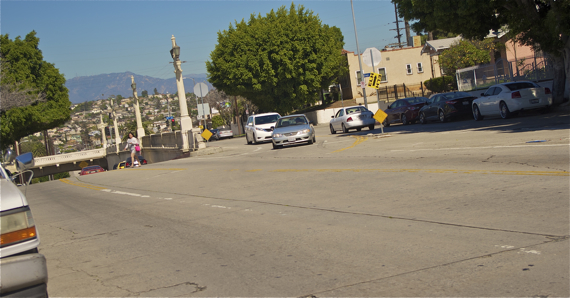
Most looking to cross do what the woman above did, which was to cross at the peak of the hill, where cars are just starting to move up or down the hill under the bridge.
The problem (besides the obvious) is that the street is curved at such an angle that it is hard for a pedestrian or cyclist at the top of the hill to see southbound traffic coming (or vice versa). So, where she is crossing -- the point at which cars are usually moving at their fastest -- actually turns out to be the "safest" place to cross.
On the north side of 4th, there is a staircase a pedestrian could walk down, if they preferred to try their luck walking along under the bridge.
But, the sidewalk along the underpass, at least on the east side, is incredibly narrow.
The sidewalk on the west side is better but, again, it isn't easy to get there. Unless, that is, you head down the stairs a block west at Bernal, and then trek your way under the bridge to Lorena, as that's the only connection between the two streets for 1200+ ft.
All of this assumes, of course, that you can manage stairs (i.e. are not pushing a stroller or are otherwise impaired).
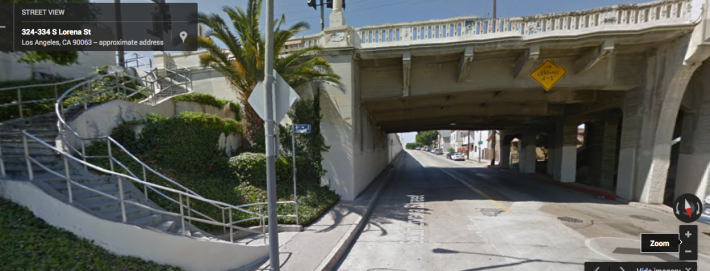
Recently, Huizar nominated Lorena as a Great Streets candidate, along with Cesar Chavez Ave. (I've documented some problems here), East 1st St., East 4th St., Mission Rd., Olympic Blvd. (documented here), Whittier Blvd., and Soto St. And, Lorena is slated to get bike lanes between Cesar Chavez and Grande Vista (south of Olympic) at some point before 2016.
The improvements couldn't come soon enough for neighbors in the area.

When they do arrive -- which likely won't be for some time, unfortunately -- the improvements need to come in the form of both infrastructure and upkeep.
Each of the Great Streets candidates Huizar named, besides lacking things like sufficient pedestrian lighting, adequate crosswalks, or level sidewalks, also boast abandoned shopping carts, trash lining the curbs, dumped furniture, struggling greenery, or some combination thereof which make the streets feel even more unfriendly.
The poor conditions of the streets create a bleak environment for youth who are growing up in a community already burdened with a number of challenges.
Unsafe crossings, like those at Lorena, can present a very real danger and communicate to them, and to all residents, that the city does not care about their well-being.
Unclean streets, in addition to being unsightly and unwelcoming, serve to chip away at youths' self-esteem while reinforcing more jaded residents' beliefs that the unsafe crossings are not a fluke.
"You've wondered if the poor infrastructure meant the city really didn't care about you," piles of trash seem to say to residents. "We've sat here, festering, untouched for months, just so that you weren't left with any doubts."






